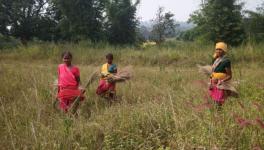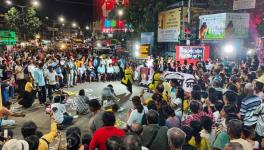Bengal Coal-Mining Project Raises Many Questions of Equity
The sixth Bengal Business Global Summit, hosted on 20-21 April in Kolkata, had an unplanned consequence: a light being shone again on Chief Minister Mamata Banerjee’s pet project, coal-mining in the Deucha-Pachami area in Birbhum district.
The project has all the fingerprints of a classic land-grab that is bad for the residents of the area, the local ecology, which includes substantial forest cover, and the environment in general. There is also the issue of illegal quarrying and the role of local Trinamool Congress bosses in running the trade.
A little bit of background would be in place. The Deucha-Pachami mines, spread over 13.4 sq. km, is the world’s second largest greenfield coal block, with estimated reserves of around 1,200 million tonnes of coal and 1,400 cubic metres of basalt. Of the area covered by the mines, about 1,000 acres is government land, of which 300 acres are covered by forests. The total extent o forest cover cannot be easily ascertained.
Though the region is mainly populated by the Santhal people, it is not covered under Schedule V of the Constitution, which is supposed to protect areas marked by a preponderance of tribal people; remoteness; underdevelopment; and high economic disparities. These are not spelt out in the Constitution and are, therefore, subjective and contextual—areas may be bought under the Schedule at any time.
The area is not even covered by the Panchayats (Extension to Scheduled Areas) Act, 1996, which provides for consultation with gram sabhas on projects that could have adverse impacts on the environment. To complete the triple whammy, it doesn’t appear that the Scheduled Tribes and Other Traditional Forest Dwellers (Recognition of Forest Rights) Act (FRA), 2006, is coming into play either. We shall return to this point at length.
An organisation formed by affected villagers called the Birbhum Jomi Jeeban Jibika Prakriti Bachao Mahasabha, has been spearheading the movement against the project. The Birbhum Adibasi Gaota, a traditional Santhal organisation, and the district chapter of the Project Affected People’s Association are also involved. Opposition parties, too, have organised against the project.
Whatever the contours of the project, West Bengal Chief Minister Mamata Banerjee could hardly have expected anything but a bumpy ride. The irony of her facing a movement against a development project involving the acquisition of land will not have escaped anyone. However much she and her party may try to spin it now, the question of her riding to power on the back of movements against the acquisition of land in Singur and Nandigram will remain. Government apologists could argue that the violence that broke out in both places played a crucial role in turning the tide in Banerjee’s favour and that Deucha-Pachami has not witnessed widespread violence. But that could well be due to the fact that push hasn’t come to shove yet. While no one wants to witness a conflagration, one doesn’t know, either, what will happen when attempts are actually made to take possession of the land and operationalise the project.
Let us look at the broad contours of the compensation package drawn up by the state government. It has a financial component and provisions for employment in the police force or, failing that, other departments. The problem is that India’s development story is littered with the debris of broken promises, especially when it comes to tribal populations, who are not unaware of the history.
What, they are asking, will happen to people settled on government land, who do not have land deeds? What, too, will happen to the people who depend to a greater or lesser extent on forest produce to make ends meet? And, as for the jobs, legitimate questions swirl around the character of the contracts that will govern them and about the older people who are dependent on themselves and will not get jobs.
In any case, 5,100 jobs are said to be on offer, with the number of displaced people estimated at last count to be in the region of 21,000: of them over 9,000 are tribal people, mainly the Santhals, and over 3,000 belong to different Scheduled Castes. Around 65% of India’s population is considered to be of working age—jobs have been planned for about 25% of the displaced in Deucha-Pachami.
There are other problems. Given the availability of basalt, there are a number of quarries in the area, most of which are reportedly illegal. The government has announced an extra amount of compensation for quarry-owners, though whether that will cover all establishments, including the illegal ones or not is unclear. It is probably no coincidence that Deucha-Pachami is in a block neighbouring Rampurhat block, where the Bogtui massacre took place. It was connected to conflicts between warring Trinamool Congress factions over the control of illegal activities including illegal quarrying on a large scale.
In any case, those who work in these quarries, and show a high incidence of silicosis, will be left in the lurch, as will over 2,600 agricultural labourers and almost 4,000 salaried workers, including main and marginal ‘household industry workers’ and ‘other workers’, going by the 2011 Census.
Then there is the environmental question. Coal-based power plants in India generate 2.5% of the world’s emissions of greenhouse gases (GHG) and 1.1 gigatonnes of CO2 annually, according to the Centre for Science and Environment, Delhi. India already produces around 75% of its electricity burning coal. Thermal plants produce about half of India’s annual CO2 emissions and about a third of its GHGs. Should we be scaling these figures upwards?
We must return to the question of forests and the people who depend on it for their livelihoods and the curious question of whatever happened to the FRA. In February 2019, the Supreme Court ordered 21 states to evict forest-dwellers whose claims to rights under the FRA had been rejected. Around a fortnight later, it stayed its eviction order seeking procedural details. The original petitioners who had sought orders striking down the FRA as being unconstitutional, have withdrawn their petitions.
The FRA case was last listed to be heard in January 2020. It hasn’t yet been heard. Meanwhile, because of the withdrawal of the original petitions, the challenge to the Act has been reduced to questions of eviction and due process. Though it would appear that the Supreme Court is at liberty to address the issue of constitutionality as well.
With the rigours of the pandemic currently seeming to be in abeyance, there is really no reason why this question should not be settled. The FRA, alongside a number of other laws passed by the first United Progressive Alliance government, was a seminal piece of legislation, which affects the lives of some of the most deprived and exploited people of the country.
Assaults on them, their livelihoods and ways of life keep occurring—Bengal today could pop up somewhere else tomorrow. A validation of the constitutionality of FRA would be a big step in the right direction.
The author is a freelance journalist and researcher. The views are personal.
Get the latest reports & analysis with people's perspective on Protests, movements & deep analytical videos, discussions of the current affairs in your Telegram app. Subscribe to NewsClick's Telegram channel & get Real-Time updates on stories, as they get published on our website.
























